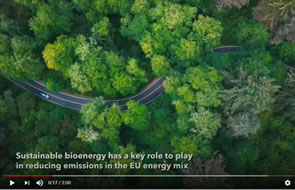Bioenergy in the Energy Transition – New Video
Europe aims to achieve an economy with net-zero greenhouse gas emissions by 2050. This objective is at the heart of the European Green Deal and in line with the EU’s commitment under the Paris Climate Agreement.
Sustainable bioenergy has a key role to play in reducing emissions in the EU energy mix.
Today biomass is already the main source of renewable energy in the EU and it is necessary to contribute to the European climate targets. This can be achieved, and it must be done always complying with sound sustainability criteria for GHG emission reductions and land use, along the whole biomass value chain. In the power sector, bioenergy can be used as a flexible energy carrier for grid balancing, allowing for higher shares of renewable electricity from wind and solar into the grid. In the transport sector, advanced drop-in biofuels are an option to reduce the use of fossil fuels in existing car fleets, without requiring a complete infrastructure change.
Advanced biofuels are also important to decarbonize sectors such as heavy-duty and long-haul transport, aviation and maritime, where other options such as electrification and hydrogen are not available yet. Today, 21 plants are already operational in the EU, providing a capacity of 358,828 tons per year of advanced biofuels. Nine new plants are under construction and will add an additional capacity of 151,900 tons per year. Plans for 1.7 million tons of further capacity have been announced.
Through continuous research and development, it is possible to increase the process efficiency and to reduce the costs of the existing technologies, as well as to develop new ones. As a very versatile resource biomass can be used to build hybrid systems and synergies with other renewable sources and energy carriers, connecting electromobility, hydrogen, bioenergy, and biofuels in the EU strategy towards net zero emissions.

